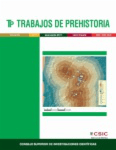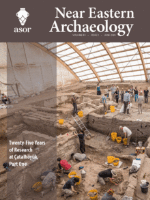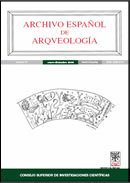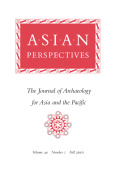
Trabajos de Prehistoria
Scope & Guideline
Pioneering Research That Shapes Our Understanding of Ancient Civilizations
Introduction
Aims and Scopes
- Archaeological Analysis:
The journal emphasizes archaeological methodologies, including excavation reports, artifact analysis, and site interpretations that contribute to the broader understanding of prehistoric communities. - Cultural and Social Dynamics:
Research often explores the social organization, cultural practices, and interactions between different prehistoric groups, providing insights into the complexities of ancient societies. - Technological Innovations:
A focus on technological advancements in prehistoric times, such as metallurgy, tool-making, and subsistence strategies, reflecting the evolution of human ingenuity. - Interdisciplinary Approaches:
The journal promotes interdisciplinary research, integrating perspectives from anthropology, history, and environmental science to enrich the understanding of prehistoric life. - Regional Studies:
Special attention is given to the Iberian Peninsula, with studies addressing regional variations in prehistoric practices, material culture, and environmental adaptations.
Trending and Emerging
- Urbanization and Settlement Patterns:
There is an increasing focus on the development of urban centers and settlement structures in prehistoric societies, reflecting a trend towards understanding how social organization and economic practices shaped early cities. - Interdisciplinary Research Methodologies:
Recent papers indicate a growing trend in employing interdisciplinary methodologies, integrating archaeological findings with advances in genetics, environmental science, and experimental archaeology. - Material Culture and Symbolism:
An emerging interest in the symbolism and meaning of artifacts, including ceramics, tools, and decorative items, suggests a deepening exploration of how material culture reflects social identities and values. - Climate Change and Human Resilience:
The impact of climatic events on prehistoric societies is becoming a prominent theme, indicating a shift towards understanding how ancient communities adapted to environmental changes. - Funerary Practices and Rituals:
Recent studies have increasingly focused on funerary practices, offering insights into the social and cultural significance of burial customs and the treatment of the dead in prehistoric societies.
Declining or Waning
- Paleolithic Studies:
There has been a noticeable decrease in publications focused specifically on the Paleolithic era, suggesting a shift towards later prehistoric periods and the complexities of Bronze and Iron Age societies. - Gender Studies in Prehistory:
Although earlier volumes featured numerous studies on gender roles in prehistoric contexts, recent issues have seen fewer contributions in this area, possibly reflecting a broader trend in archaeological research. - Bioarchaeology and Human Remains Analysis:
Research centered on bioarchaeological approaches, particularly those involving human skeletal remains, appears to be waning, indicating a possible narrowing of focus towards material culture and societal structures. - Neolithic Agricultural Practices:
While foundational to the understanding of prehistoric economies, studies specifically addressing Neolithic agricultural practices have become less frequent, possibly overshadowed by broader investigations into societal dynamics.
Similar Journals

Gladius
Illuminating the Past: Rigorous Research for a Richer UnderstandingGladius is a prestigious academic journal dedicated to the field of History, published by CONSEJO SUPERIOR INVESTIGACIONES CIENTIFICAS-CSIC in Spain. With an ISSN of 0436-029X and E-ISSN 1988-4168, this journal has been a cornerstone for historical scholarship since it became Open Access in 1961, providing free and unrestricted access to its rich array of studies. Having achieved a commendable Q2 ranking in the Arts and Humanities History category for 2023, Gladius is recognized for its rigorous peer-reviewed articles that contribute significantly to the understanding of historical contexts and developments. It is indexed within Scopus, ranked #659 out of 1760 in its field, and boasts a 62nd percentile, highlighting its relative prominence among its peers. Located in Madrid, Spain, Gladius continues to foster intellectual growth and debate, making it an invaluable resource for researchers, professionals, and students seeking to deepen their knowledge and engage with contemporary historical discourse.

NEAR EASTERN ARCHAEOLOGY
Advancing Knowledge Through Archaeological DiscoveryNEAR EASTERN ARCHAEOLOGY, published by University of Chicago Press, is a premier journal dedicated to the field of archaeology, particularly focusing on the rich cultural heritage and archaeological findings of the Near East. With an ISSN of 1094-2076 and an E-ISSN of 2325-5404, this esteemed publication provides a vital platform for scholars and practitioners to share their research, insights, and discoveries. The journal holds an impressive ranking in the Q1 quartile for both Archaeology and History in 2023, reflecting its significant impact within these fields and a robust history of scholarly contribution. The journal has been pivotal in shaping discussions around archaeological methodology, theory, and contemporary issues from 2002 to 2024, as it continues to reach a wide audience through various access options. With Scopus rankings placing it in the top percentiles for both History and Archaeology, NEAR EASTERN ARCHAEOLOGY represents an essential resource for researchers, professionals, and students alike, fostering the exploration and understanding of the region's archaeological narrative.

Fornvannen-Journal of Swedish Antiquarian Research
Bridging the Past and Present of Swedish HistoryFornvannen - Journal of Swedish Antiquarian Research is a distinguished peer-reviewed journal dedicated to advancing the field of antiquarian studies through rigorous research and scholarship. Published by the Royal Academy Letters, History & Antiquities in Sweden, this journal has been a cornerstone of archaeological and historical discourse since its inception in 1978. It currently holds an esteemed position in the Q3 category in both Archaeology and History as per the 2023 assessments, reflecting its commitment to promoting high-quality academic contributions. With an ISSN of 0015-7813 and an E-ISSN of 1404-9430, Fornvannen provides insights into Swedish antiquities and serves as a vital resource for researchers and scholars eager to explore the nuances of archaeological and historical findings. Although not an open-access journal, it offers a comprehensive platform for the dissemination of knowledge within the fields of arts and humanities. As it continues its journey from 2011 to 2024, Fornvannen remains pivotal in fostering scholarly dialogue and enhancing our understanding of Sweden’s rich historical tapestry.

Conimbriga-Revista de Arqueologia
Fostering Collaboration in the World of Archaeological InquiryConimbriga-Revista de Arqueologia is a distinguished open-access journal dedicated to the field of archaeology, published by COIMBRA UNIVERSITY PRESS. Since its inception, the journal has fostered a vibrant intellectual community focused on the exploration and dissemination of archaeological research, particularly emphasizing studies relevant to the rich historical and cultural heritage of Portugal and beyond. With its open access model established in 2014, it has become a vital resource for researchers, professionals, and students to share their findings without access barriers, encouraging collaboration and knowledge exchange. Despite the absence of specific metrics such as the HIndex and Scopus rankings, the journal is recognized for its commitment to high-quality scholarship and its role in advancing archaeological discourse. Positioned within the scholarly landscape, Conimbriga-Revista de Arqueologia serves as a crucial platform for the publication of innovative research, reviews, and critical essays, making it an essential journal for those invested in the archaeological sciences.

Archivo Espanol de Arqueologia
Elevating archaeological discourse through quality research.Archivo Español de Arqueología is a prestigious journal published by the Consejo Superior de Investigaciones Científicas (CSIC), dedicated to the field of archaeology and the historical sciences. Since its transition to Open Access in 1991, this journal has been a significant resource for scholars and practitioners in Spain and beyond, ensuring the dissemination of high-quality research to a broad audience. With an impressive Scopus ranking that places it within the top 20% of journals in the disciplines of History and Archaeology, Archivo Español de Arqueología plays a crucial role in advancing academic discourse and promoting innovative archaeological methodologies. The journal has maintained rigorous standards, reflected in its placement within the Q2 and Q3 quartiles, enabling it to establish a reputation for excellence and reliability in archaeological scholarship. Researchers, professionals, and students are encouraged to explore the journal's diverse array of articles from its foundation year of 2009 to the present, enriching their understanding of the past through the latest findings and theoretical advancements in archaeology.

Slovenska Archeologia
Exploring the depths of Slovakia's rich archaeological heritage.Slovenska Archeologia is a prominent journal published by the Slovak Academy of Sciences, Institute of Archaeology, dedicated to advancing the field of archaeology through rigorous scholarly research and insightful scholarship. With an ISSN of 1335-0102 and an E-ISSN of 2585-9145, this journal has been a vital platform for archaeologists and academics since its inception, converging its insightful publications from the years 2017 to 2023. Awarded a Q2 ranking in the field of archaeology across both arts and humanities categories, it holds a respectable position in the Scopus rankings, recognizing its contributions to the discipline. Based in Slovakia, the journal is an essential resource for professionals, researchers, and students interested in archaeological findings and methodologies. While it does not currently offer Open Access options, its commitment to promoting high-quality research makes it a valuable addition to the academic community.

Intersecciones en Antropologia
Championing open access for global understanding.Intersecciones en Antropologia, published by the Universidad Nacional del Centro de la Provincia de Buenos Aires (UNICEN), Facultad de Ciencias Sociales, is a premier open-access journal in the field of anthropology, having established its presence since 2010. With an impressive impact factor and currently holding the distinguished Q1 quartile ranking in anthropology for 2023, this journal has quickly become a vital resource for scholars and practitioners alike, offering a platform for innovative research and critical discussion. The journal aims to advance anthropological scholarship by encouraging the dissemination of diverse perspectives and stimulating dialogue across geographical and cultural boundaries. Its open-access model, adopted in 2017, ensures that valuable research findings are accessible to a global audience, fostering collaboration and engagement within the academic community and beyond. Located in the vibrant cultural context of Argentina, Intersecciones en Antropologia serves as a conduit for significant anthropological dialogues, making it an essential read for those dedicated to understanding and contributing to the evolving landscape of social sciences.

Bulletin de la Societe Prehistorique Francaise
Elevating Archaeology: A Gateway to Our OriginsBulletin de la Societe Prehistorique Francaise (ISSN: 0249-7638; E-ISSN: 1760-7361), published by the SOCIETE PREHISTORIQUE FRANCAISE, stands as a pivotal journal within the domain of archaeology, particularly emphasizing prehistoric studies. With its classification in the Q2 quartile of both the arts and humanities as well as social sciences in archaeology, the journal positions itself among the top 25% of publications in these categories as of 2023. This distinguished ranking reflects its significant contribution to the field, providing researchers, professionals, and students with critical insights and innovative methodologies related to prehistoric research. Although open access options are currently unavailable, the journal is committed to fostering academic discourse and sharing knowledge that influences contemporary archaeological practices. As a member of the elite academic community, Bulletin de la Societe Prehistorique Francaise is highly regarded for its rigorous peer-review process and dedication to the advancement of archaeology, making it an essential resource for anyone invested in understanding our historical roots.

Asian Perspectives-The Journal of Archaeology for Asia and the Pacific
Illuminating Cultures: A Journey through Time and SpaceAsian Perspectives - The Journal of Archaeology for Asia and the Pacific is a prestigious journal published by University of Hawaii Press, focusing on the intricate field of archaeology in Asia and the Pacific. With a rich publication history dating back to 1993, the journal has established itself as a vital platform for disseminating research that illuminates the archaeological heritage and cultural dynamics of this diverse region. Recognized for its scholarly impact, it enjoys a commendable impact factor and ranks in the Q2 category for Anthropology and Archaeology, indicating its significant contribution to these fields. Although it operates on a traditional subscription-based model, the journal is accessible to institutional and individual subscribers worldwide. With an emphasis on interdisciplinary research, Asian Perspectives invites contributions that foster a deeper understanding of historical and contemporary issues through archaeology, making it an invaluable resource for researchers, professionals, and students alike committed to advancing scholarly dialogue in the region. Explore a wealth of innovative studies and insights that continue to shape the understanding of Asia and the Pacific's archaeological narrative.

Lucentum
Where History Meets InnovationLucentum is a distinguished open-access journal published by Universidad de Alicante, focusing on the interdisciplinary fields of Archeology, History, and Paleontology. Since its inception in 1982, it has established itself as a vital platform for scholars and researchers to disseminate their findings, contributing significantly to the academic landscape in Spain and beyond. The journal's notable rankings, including Q1 status in History and Q2 in Archeology, reflect its commitment to high-quality scholarship and rigorous peer review. With an impressive impact factor and recognition in Scopus, Lucentum serves as an essential resource for professionals, students, and historians, fostering a deeper understanding of cultural and historical contexts through a wealth of interdisciplinary research. The journal continues to embrace open access, ensuring that critical knowledge is freely available to the global research community.